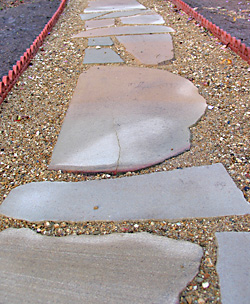|
Building
Your Garden's Paths
All
pictures of paths here are from the restoration project
at Nonsuch.
See
also Instructions
on How to Build
Garden Paths from 1828
If
you are lucky enough to be able to begin your garden restoration
with a garden cleared of most vegetation and previous
structures, then one of the first things you will be doing
is planning, then building, your garden paths or walks.
|

Sandstone
path at Nonsuch |
Paths
are used as 'walks' - a means for people to stroll
about and enjoy the garden - but they will also
be used as access routes for the real work of
gardening. Ideally they should be hard surfaced
all year round, non-slip, well drained, relatively
weed free, wide enough for two people to walk
side by side as well to ease the passage gardening
equipment, with gentle curved corners that make
it easy for walkers as well wheelbarrows, and
present a means to get about the garden in at
least one direction free of steps. They should
also provide a platform for viewing the garden
and surrounding landscape, and their layout should
invite the visitor deeper into the garden. Straight
paths can be efficient (and cheaper), but they
are generally soul-deadening.
Nonsuch's
garden is on a fairly steep hillside. When planning
the garden's hard landscaping we wanted paths
that were 'step free' in at least one direction
around the garden so that all parts could be accessed
easily by a wheelbarrow. There is absolutely nothing
worse that having to lift heavy trays or bags
of soil or manure or compost up and down stepped
sections (we know, we had to do it in our last
garden).
|
The
garden at Nonsuch does have steps and stairs along some
paths, but the entire garden is serviced by the gently
sweeping curve and slope of the central brick and sandstone
causeway that means the gardener can get his wheelbarrow
to every section of the garden without having to negotiate
steps. The gardener may have to take the long way around
to access some sections, but at least he can do it without
negotiating steps. The paths are also wide, hard surfaced,
well drained and non-slip.
If
your garden is not a restoration project, then you could
always use concrete. Well laid, it is cheap, efficient,
and does the job, and it doesn't have to look awful.
If
you are restoring a garden, then you will want
something to suit the period of your garden, or of the
house it surrounds.
Traditionally,
garden paths were constructed of:
|
Gravel
was the most favoured material (cheap, plentiful and easy to lay).
Everyone would no doubt love to have beautiful stone paths running
through their garden, but cost has always been a major factor
in their construction. Local materials can, however, often be
obtained fairly cheaply, and always look good. At Nonsuch we went
for a mixture of brick, gravel and sandstone (which matches the
sandstone used to construct the house). Sandstone everywhere would
have been wonderful, but we just could not afford it. The main
causeway of the garden is of recycled brick, and some 30% of that
brick we found in the garden. In the formal areas of the garden
we used solid sandstone, while transitional paths were of sandstone
stepping stones amid gravel. For us this meant we kept to very
traditional paths that were hard surfaced, well drained, and easy
on the eye (if not always on the purse!).
Recycled
brick is often easy and cheap to come by, makes beautiful paths
that can be easily maintained. Gravel is also be easy on the eye,
hard wearing so long as it is well laid on a good grit base, but
it can become infested with weeds.
Turf
can be easy on the eye, but it can be a nightmare in wet weather,
difficult to get gardening equipment around, and generally takes
a fair bit of effort to maintain.
There
are also products on the market today that simulate stone or brick.
The problem is with these that they simply look fake. We're not
sure that, in restoring a garden, it is a a good idea to put concrete
fake sandstone stepping stones down when the house is built of
the real thing. The house will always show up the paths. Cost
is a factor, but if you can possibly afford it, then it is always
best to go for the genuine article rather than the reproduction.
Building
a stone and gravel path.
Built on a firm and well drained footings
and edged with terracotta tiles to keep the gravel from
spilling, this is a cost effective means of building a
'stone' path that would look good in any heritage garden.
| Sandstone
slabs laid on a firm base and concreted in place. |
Salvaged
terracotta tiles put in as edging |
The
finished path. |
| . |
. |
|
Please
also visit Old London Maps
on the web as many of the maps
and views available there have plans and depictions of gardens
from
the medieval period through to the late nineteenth century.
Copyright
© Sara Douglass Enterprises Pty Ltd 2006
No material may be reproduced without permission
unless
specifically stated otherwise
|






